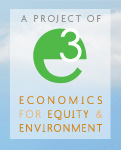Is it true that there’s no such thing as bad publicity? If so, we’re in luck. The paper that Elizabeth A. Stanton and I wrote on the social cost of carbon has been discussed on the Bishop Hill blog, a leading forum for British climate skeptics – and in comments on that blog and on Twitter by Richard Tol.
Bishop Hill cites us as estimating that the social cost of carbon – the monetary value of the present and future damage caused by emitting one ton of carbon dioxide – could be $1,000 or more. Tol calls this estimate “complete nonsense,” and Bishop Hill refers to the increase from the U.S. government’s $21 estimate to $1,000 and higher as “fairly jawdropping.”
Feel free to pick your jaw back up; we never said that the social cost of carbon is $1,000. We did say that the value should reflect important climate uncertainties, and that our modeling of those uncertainties produced a range of possible values from $28 to almost $900 for emissions today, or from $64 to about $1,500 for emissions in 2050.
A wide range of possible values is the only reasonable economic representation of scientific uncertainty about climate outcomes. Since the science says that outcomes are uncertain over a wide range, but catastrophic risks cannot be ruled out, then the corresponding economic evaluation should say that the social cost of carbon (SCC) is uncertain over a wide range, but catastrophically high costs cannot be ruled out. The reduction of the range of potential outcomes to a single, precise value such as $21 (or $1,000) slips in a radical change in the structure of information; it implausibly asserts that economists can find certainty where scientists cannot.
What are the uncertainties we considered? Using William Nordhaus’ DICE model, we examined median vs. 95th percentile climate sensitivity, high vs. low discount rates, and high vs. low estimates of damages at low temperatures, and at high temperatures. The multiple combinations of high/low estimates on four parameters gave us 16 variants of the SCC, spanning that vast range.
Richard Tol, in a comment on Bishop Hill, suggests that his forthcoming literature review of SCC estimates should be used instead of our analysis. In that article, updating his similar, earlier review, he includes 311 estimates, of which 184 (59%) come from his own publications. Those who want a Tol-centric review of the SCC literature should certainly consult his periodic updates, although readers should realize that these articles are self-referential to an extent that is unusual in academic literature reviews.
In debates on Twitter sparked by the Bishop Hill discussion, Tol has raised a number of other complaints. I am accused of having received funding from Friends of the Earth. Guilty as charged. I have also done work funded by the European Commission, various United Nations agencies, national and state governments, and charitable foundations, as well as other environmental NGOs. Tol has, on the other hand, cited obscure legal grounds for failing to reveal anything about his own funding. But really, we should judge one another’s work on the basis of its content, not its funding.
Since the Bishop Hill discussion Tol has tweeted, more than once, his belief that Liz Stanton and I are “mediocre” economists – a very weak substitute for substantive comment on our work. Come on, Richard: hurling hostile epithets at those we disagree with does nothing for the quality of debate.
And Tol has tweeted quite inaccurately about my critique of his FUND model. In an article with another co-author, I found that:
- FUND estimates that the worst economic impact of climate change will be the increased cost of air conditioning.
- FUND’s analysis of agriculture assumes a large net benefit from the first several degrees of warming, based entirely on research published in 1996 or earlier (the field has changed dramatically since then).
- Equation A.3 in the agricultural module (see the FUND documentation) of FUND versions 3.5 and earlier contains a serious risk of division by zero, for a plausible (relatively high-probability) value of one of the variables.
- FUND version 3.5, containing that software error, was one of three models used in developing the U.S. government’s estimate of the SCC. When I recalculated FUND’s SCC estimate after attempting to correct the divide-by-zero error, the number more than doubled. If you’re interested in this, read my article, and the FUND 3.5 documentation – or if you’re truly fearless, the FUND 3.5 source code.
You won’t be surprised to learn that Tol disagrees. I’m sure you’re about to have a chance to read his response.

